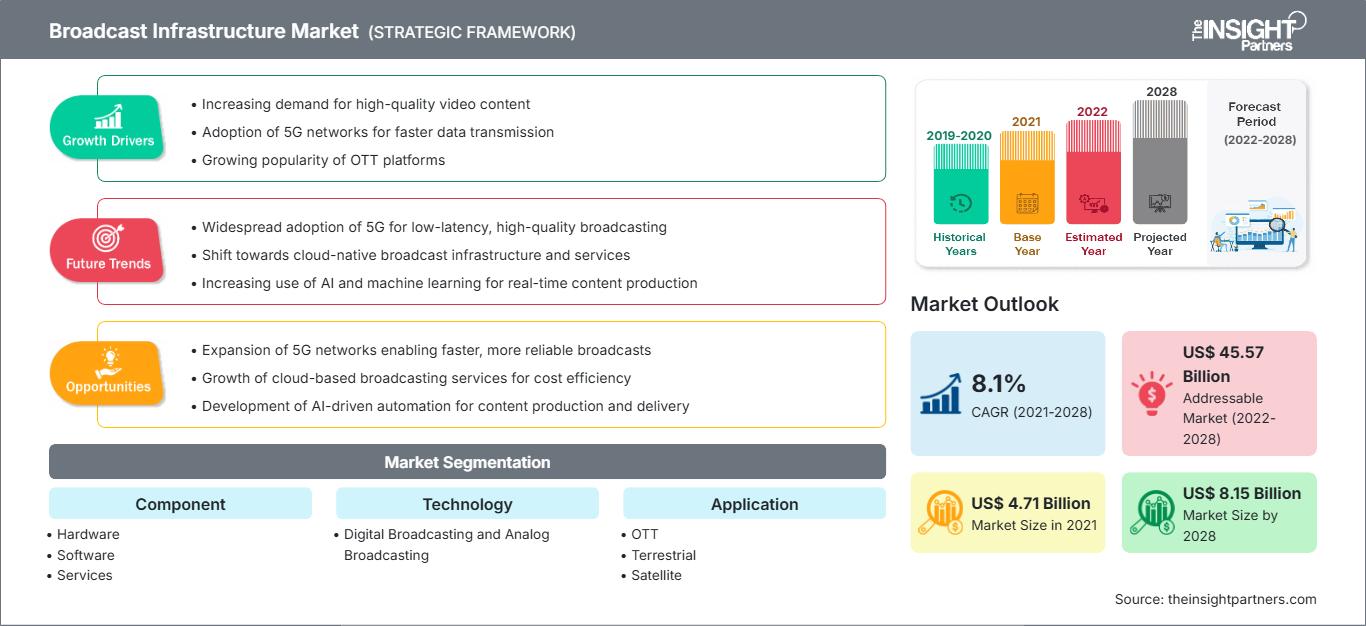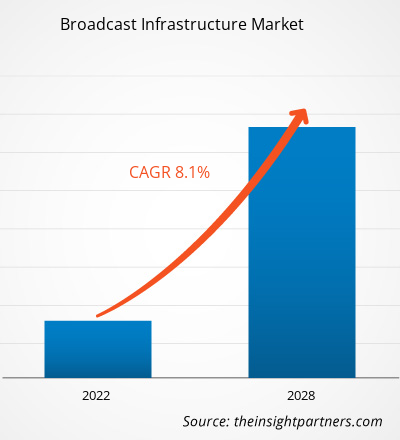[Forschungsbericht]Der Markt für Rundfunkinfrastruktur wurde 2021 auf 4.713,7 Millionen US-Dollar geschätzt und soll bis 2028 voraussichtlich 8.145,7 Millionen US-Dollar erreichen; von 2021 bis 2028 wird ein durchschnittliches jährliches Wachstum von 8,1 % erwartet.
Der Paradigmenwechsel der Rundfunkbranche von analoger zu digitaler Technologie hat eine fortschrittliche, aber relativ komplexe Rundfunkinfrastruktur hervorgebracht. Die Rundfunkbranche verzeichnet eine erhebliche Nachfrage nach neuen Übertragungstechnologien wie Internet Protocol Television (IPTV), Web-TV, hochauflösendem Fernsehen (HDTV) und Pay-per-View. Die Nachfrage nach verbesserten Videoerlebnissen dürfte Rundfunkanstalten weltweit, insbesondere in Asien, den Weg ebnen. Ein weiterer wichtiger Faktor für den Markt für Broadcast-Infrastruktur sind integrierte Plattformen, bestehend aus Servern, Set-Top-Boxen und Videoinhaltsschutzsystemen sowie entsprechenden Tools, Middleware und Abrechnungssystemen. Diese ermöglichen die Bereitstellung einer Vielzahl von TV-Diensten in verschiedenen Formaten, wie Video-on-Demand, Streaming und zeitversetztes Fernsehen, basierend auf einer Kombination aus zugrunde liegenden IP-Netzwerken und DSL- oder optischen Zugangssystemen. Aufgrund der hohen Kosten für Broadcast-Hardware-Infrastruktur, der hohen Wartungskosten und der häufigen Hardware-Upgrades wechseln Anbieter heutzutage von hardwarebasierter Infrastruktur zu softwarebasierter Infrastruktur. Die Rundfunkbranche erlebt revolutionäre Innovationen mit technologischen Entwicklungen, um den Nutzern ein besseres Erlebnis zu bieten und Chancen für Anbieter von Broadcast-Infrastruktur zu schaffen.
Passen Sie diesen Bericht Ihren Anforderungen an
Sie erhalten kostenlos Anpassungen an jedem Bericht, einschließlich Teilen dieses Berichts oder einer Analyse auf Länderebene, eines Excel-Datenpakets sowie tolle Angebote und Rabatte für Start-ups und Universitäten.
Markt für Rundfunkinfrastruktur: Strategische Einblicke

-
Holen Sie sich die wichtigsten Markttrends aus diesem Bericht.Dieses KOSTENLOSE Beispiel umfasst Datenanalysen, die von Markttrends bis hin zu Schätzungen und Prognosen reichen.
Während der COVID-19-Pandemie arbeiten viele Menschen von zu Hause aus, verbringen mehr Zeit online und feiern die digitale Transformation. Diese Nachfrage nach digitalen Ressourcen belastet die Systeme zahlreicher Software- und Plattformunternehmen zusätzlich und beeinträchtigt ihre Fähigkeit, zuverlässige und qualitativ hochwertige Dienste bereitzustellen. Der COVID-19-Ausbruch hat sich jedoch aufgrund von Geschäftsschließungen und Arbeitskräftemangel negativ auf die Akteure ausgewirkt, die an der Bereitstellung von Videoinhalten für Endnutzer beteiligt sind. Die COVID-19-Krise hat außerdem die Abläufe entlang der Wertschöpfungskette – von Lieferantennetzwerken bis hin zum Kundenerlebnis – aufgrund von Geschäftsschließungen, Reiseverboten und Lieferkettenunterbrechungen drastisch auf den Kopf gestellt.
Markteinblicke – Markt für Broadcast-Infrastruktur: Zunehmende Akzeptanz neuer Broadcast-Technologien
Mit der kontinuierlichen Verbesserung der Digitalisierung und einem Anstieg des verfügbaren Einkommens erlebt der Markt eine hohe Akzeptanz von IPTV und HDTV. Die Nachfrage nach verbesserten Videoerlebnissen dürfte den Weg für Rundfunkanstalten weltweit, insbesondere in Asien, ebnen. Die Verbreitung von Breitbandverbindungen nimmt in der gesamten Region Asien-Pazifik aufgrund des On-Demand-Angebots der Verbraucher zu. Darüber hinaus gewinnen abonnementbasierte Over-the-Top-Plattformen (OTT) wie Netflix in Asien an Bedeutung. Erhöhte staatliche Ausgaben für Cloud-basierte Infrastruktur, Cloud-basierte Lösungen und Managed Services sowie Hybridnetzwerke dürften das Wachstum des Marktes für Rundfunkinfrastruktur ankurbeln. Wachsende Sicherheitsbedenken und die Aufrechterhaltung des Kundenvertrauens werden die Rundfunkveranstalter dazu ermutigen, neue Bereitstellungsmodelle einzuführen. Alle Fortschritte und Entwicklungen dürften sich im Prognosezeitraum positiv auf das Marktwachstum auswirken.
Komponentenbasierte Einblicke
Basierend auf den Komponenten ist der Markt für Rundfunkinfrastruktur in Hardware, Software und Service segmentiert. Das Softwaresegment hatte 2020 den größten Marktanteil.
Markt für Rundfunkinfrastruktur
Die Analysten von The Insight Partners haben die regionalen Trends und Faktoren, die den Markt für Broadcast-Infrastruktur im Prognosezeitraum beeinflussen, ausführlich erläutert. In diesem Abschnitt werden auch die Marktsegmente und die geografische Lage in Nordamerika, Europa, dem asiatisch-pazifischen Raum, dem Nahen Osten und Afrika sowie Süd- und Mittelamerika erörtert.Umfang des Marktberichts zur Rundfunkinfrastruktur
| Berichtsattribut | Einzelheiten |
|---|---|
| Marktgröße in 2021 | US$ 4.71 Billion |
| Marktgröße nach 2028 | US$ 8.15 Billion |
| Globale CAGR (2021 - 2028) | 8.1% |
| Historische Daten | 2019-2020 |
| Prognosezeitraum | 2022-2028 |
| Abgedeckte Segmente |
By Komponente
|
| Abgedeckte Regionen und Länder |
Nordamerika
|
| Marktführer und wichtige Unternehmensprofile |
|
Dichte der Marktteilnehmer im Bereich Rundfunkinfrastruktur: Auswirkungen auf die Geschäftsdynamik verstehen
Der Markt für Broadcast-Infrastruktur wächst rasant. Dies wird durch die steigende Endverbrauchernachfrage aufgrund veränderter Verbraucherpräferenzen, technologischer Fortschritte und eines stärkeren Bewusstseins für die Produktvorteile vorangetrieben. Mit der steigenden Nachfrage erweitern Unternehmen ihr Angebot, entwickeln Innovationen, um den Bedürfnissen der Verbraucher gerecht zu werden, und nutzen neue Trends, was das Marktwachstum weiter ankurbelt.

- Holen Sie sich die Markt für Rundfunkinfrastruktur Übersicht der wichtigsten Akteure
Akteure im Markt für Rundfunkinfrastruktur konzentrieren sich hauptsächlich auf die Entwicklung fortschrittlicher und effizienter Produkte.
- Im Juni 2021 gab EVS, der führende Anbieter von Live-Videotechnologie für Rundfunk- und neue Medienproduktionen, seine Partnerschaft mit Gravity Media bekannt, um das Xeebra-Mehrkamera-Reviewsystem als Kerntechnologie für die neue integrierte Videobeurteilungs- und Kommunikationslösung des Unternehmens zu liefern.
- Im Juni 2021 gab Ross Video die Übernahme von Primestream bekannt, einem Unternehmen für Media-Asset-Workflow-Lösungen. Diese Lösungen werden von Kunden in verschiedenen Marktsegmenten eingesetzt, darunter Unternehmen, digitale Medien, Sport und Rundfunk. Ihre Lösungen sind darauf ausgelegt, die einzigartigen und zunehmend komplexen kreativen, geschäftlichen und technologischen Herausforderungen in jedem Markt zu lösen. Durch diese Übernahme wird Ross natürlich versuchen, seine Streamline-Lösung für das Medien-Asset-Management im Laufe der Zeit mit den Primestream-Produkten zu kombinieren, um eine vollständig konvergente Plattform für das Grafik- und Produktions-Asset-Management zu schaffen.
Der Markt für Rundfunkinfrastruktur wurde wie folgt segmentiert: Markt für Rundfunkinfrastruktur – nach Komponente
- Hardware
- Software
- Dienste
Markt für Rundfunkinfrastruktur – nach Technologie
- Digitaler Rundfunk
- Analoger Rundfunk
Markt für Rundfunkinfrastruktur – nach Anwendung
- OTT
- Terrestrisch
- Satellit
- IPTV
- Sonstige
Markt für Rundfunkinfrastruktur – nach Geografie
- Nordamerika
- USA
- Kanada
- Mexiko
- Europa
- Deutschland
- Frankreich
- Italien
- Großbritannien
- Russland
- Rest von Europa
- Asien-Pazifik (APAC)
- Australien
- China
- Indien
- Japan
- Südkorea
- Rest von APAC
- Naher Osten und Afrika (MEA)
- Saudi-Arabien
- VAE
- Südafrika
- Rest von MEA
- Südamerika (SAM)
- Brasilien
- Argentinien
- Rest von SAM
Markt für Rundfunkinfrastruktur – Firmenprofile
- Cisco Systems, Inc.
- Clyde Broadcast Technology
- CS Computer Systems Ltd.
- Dacast Inc.
- EVS Broadcast Equipment SA
- Grass Valley
- Kaltura
- Nevion
- Ross Video Ltd
- Zixi
- Historische Analyse (2 Jahre), Basisjahr, Prognose (7 Jahre) mit CAGR
- PEST- und SWOT-Analyse
- Marktgröße Wert/Volumen – Global, Regional, Land
- Branchen- und Wettbewerbslandschaft
- Excel-Datensatz
Aktuelle Berichte
Verwandte Berichte
Erfahrungsberichte
Grund zum Kauf
- Fundierte Entscheidungsfindung
- Marktdynamik verstehen
- Wettbewerbsanalyse
- Kundeneinblicke
- Marktprognosen
- Risikominimierung
- Strategische Planung
- Investitionsbegründung
- Identifizierung neuer Märkte
- Verbesserung von Marketingstrategien
- Steigerung der Betriebseffizienz
- Anpassung an regulatorische Trends






















 Kostenlose Probe anfordern für - Markt für Rundfunkinfrastruktur
Kostenlose Probe anfordern für - Markt für Rundfunkinfrastruktur